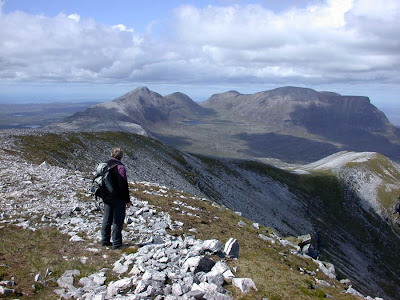Sunday, June 24, 2007
Back in Taplow, I went for a walk and found the pair of firecrests still feeding at least two young in the hollies near the top of Berry Hill, between the public footpath and the cricket ground. As well as singing from the male and the usual si-si noises, there was a harsh sound from one of the fledglings when the other one got too close. This was the last I would see of the Taplow firecrest family.
Scotland: 16th-23rd June
We stayed for the week in one of the white houses at Ardmair, a few miles north of Ullapool.
Scotland: 16th-23rd June
We stayed for the week in one of the white houses at Ardmair, a few miles north of Ullapool.

Our first hill-walk was Glas Bheinn ("glashvin") in Assynt. Greger looks over to Quinag, which we walked two years ago. With five tops linked by a fine rocky ridge Quinag was a long but fabulous outing.
We saw no ptarmigan but they are present in the area. These pictures were taken by Greger two years ago on Quinag, where we also saw a female with four small chicks.

 The following day we drove south along the coast road. From high above Gruinard Bay we looked down to see five black-throated divers, close in under the cliff. We saw a little of their strange, group circle-swimming and diving before they broke up and drifted away.
The following day we drove south along the coast road. From high above Gruinard Bay we looked down to see five black-throated divers, close in under the cliff. We saw a little of their strange, group circle-swimming and diving before they broke up and drifted away.  The following day we drove north to Ben Stack, the hill on which Labour politician and ex-minister Robin Cook collapsed and died. From some viewpoints it's the archetypal conical mountain, so despite its modest height the climb is quite a tough one.
The following day we drove north to Ben Stack, the hill on which Labour politician and ex-minister Robin Cook collapsed and died. From some viewpoints it's the archetypal conical mountain, so despite its modest height the climb is quite a tough one.
This is looking south-east along Loch More.
 The top of the hill is split by a landslip (The Corbetts & other Scottish Hills - edited by Rob Milne and Hamish Brown), with two rocky ribs enclosing a grassy trough. In my eagerness to reach the summit I forgot to watch for ptarmigan, but Greger heard a croak and called out just as four or five of them flew down the mountainside out of sight. Typical!
The top of the hill is split by a landslip (The Corbetts & other Scottish Hills - edited by Rob Milne and Hamish Brown), with two rocky ribs enclosing a grassy trough. In my eagerness to reach the summit I forgot to watch for ptarmigan, but Greger heard a croak and called out just as four or five of them flew down the mountainside out of sight. Typical!
It's a curious summit altogether, with a shelter and triangulation pillar on the lower top, and the real top just past the solar-powered aerial. (No idea what that's for!)
 The rocky crest beyond the summit cairn was the start of our route of descent. As we left the top, it began to drizzle.
The rocky crest beyond the summit cairn was the start of our route of descent. As we left the top, it began to drizzle.
 The rocky crest beyond the summit cairn was the start of our route of descent. As we left the top, it began to drizzle.
The rocky crest beyond the summit cairn was the start of our route of descent. As we left the top, it began to drizzle.
A little way down the flank of the mountain we saw a splendid male ring ouzel, then the female and at least two young.
 By now it was raining hard and occasionally thundering, and it got steadily worse as we descended. The 5-kilometre road walk along Loch Stack, which had promised a pleasant end to the day, was now a tedious wet slog. However, we saw a cuckoo and heard several willow warblers and at the reedy tip of the loch two greenshank chicks were being watchfully protected by hysterical parents. They calmed down once we had passed.
By now it was raining hard and occasionally thundering, and it got steadily worse as we descended. The 5-kilometre road walk along Loch Stack, which had promised a pleasant end to the day, was now a tedious wet slog. However, we saw a cuckoo and heard several willow warblers and at the reedy tip of the loch two greenshank chicks were being watchfully protected by hysterical parents. They calmed down once we had passed.
For our final day we took the ferry to Handa Island, which cost £10 each. It was worth it. The weather stayed fine, the cliff scenery was fantastic and we had great views of nesting seabirds.
Greger took this shot of Puffin Bay with his mobile and managed to get a great skua in it. A peregrine circled for a while then flew off towards the mainland.
 We saw one pair of light-phase Arctic skuas, which spent most of their time chasing great skuas with their evocative "yarow! yarow!" cry. The dark-phase birds were more laid-back.
We saw one pair of light-phase Arctic skuas, which spent most of their time chasing great skuas with their evocative "yarow! yarow!" cry. The dark-phase birds were more laid-back.In fact, this individual standing right by the path is obviously a bit of a poser because a very similar photo appears on the birdguides website.



